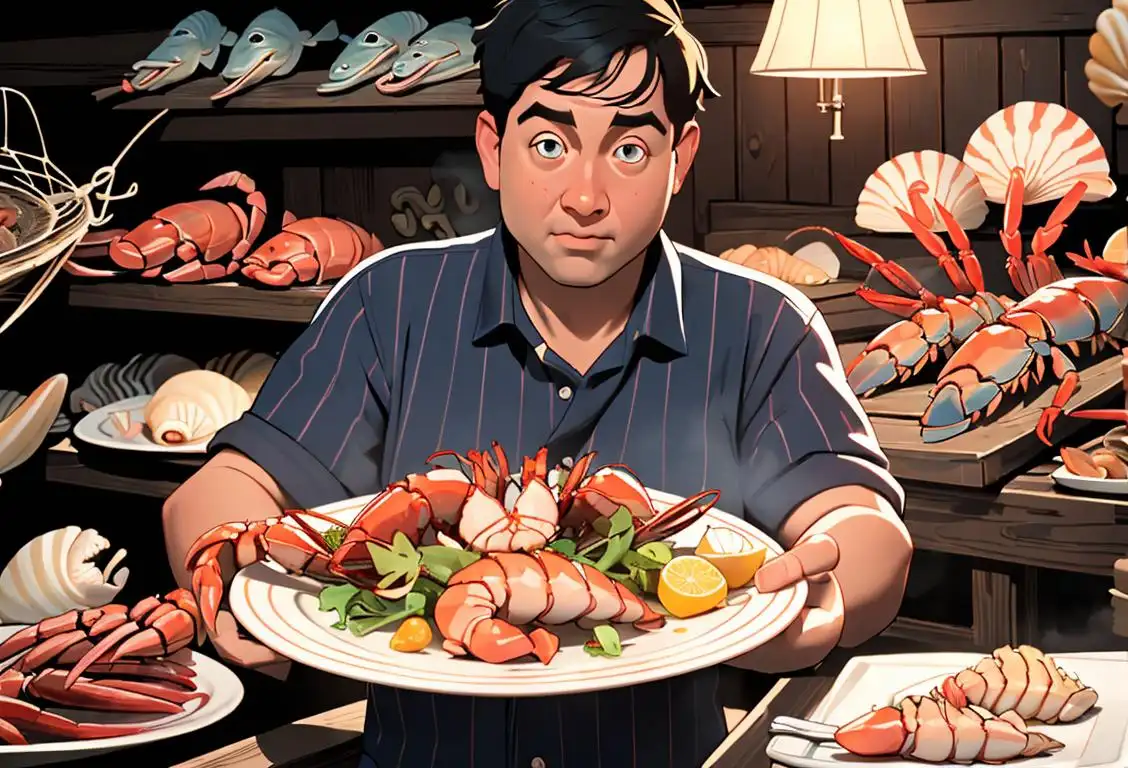National Seafood Day

Seafood lovers, rejoice! Get your taste buds ready, because National Seafood Day is here to satisfy all your maritime cravings. Whether you're a fan of crispy fish and chips or melt-in-your-mouth shrimp scampi, this is the day to indulge in the ocean's bountiful delights. So grab your bibs and seafood crackers, because we're diving into the deep blue sea of deliciousness!
When is Seafood Day?
It's national seafood day on the 19th October.
The Origins of National Seafood Day
Have you ever wondered how National Seafood Day came to be? Well, let me reel in the facts for you. This special day has been celebrated on October 19th since 2015, making it a relatively young addition to our culinary calendar. While the exact origins of this foodie holiday remain a mystery, we can guess that it was created by seafood enthusiasts who wanted to give their favorite dishes the recognition they deserve.
Seafood has been enjoyed by humans for thousands of years. From ancient civilizations who netted their dinner to modern-day seafood festivals that celebrate the ocean's harvest, seafood holds a special place in our hearts, and more importantly, our stomachs.
How to Celebrate National Seafood Day
Now that you know the story behind National Seafood Day, it's time to get down to business - or should I say, get down to the feast! Here are a few ways you can celebrate this delectable day:
- Visit a seafood restaurant: Treat yourself to a mouthwatering meal at your favorite seafood joint. Whether you're in the mood for succulent lobster, buttery crab legs, or tangy ceviche, there's something to please every seafood aficionado.
- Cook up a storm: Put on your chef's hat and whip up a seafood extravaganza in your own kitchen. From classic dishes like shrimp scampi to innovative creations like salmon tacos, there are endless recipes to explore.
- Host a seafood boil: Gather your loved ones for a good old-fashioned seafood boil. Fill a large pot with shrimp, crab, corn, and potatoes, and let it all simmer in a flavorful broth. It's a feast fit for kings and queens of the sea!
- Learn about sustainable fishing: Take this day as an opportunity to educate yourself about sustainable fishing practices. With the growing concern about overfishing and its impact on the environment, it's important to make informed choices when buying seafood.
Did You Know?
Here's a fun fact to tickle your taste buds: Did you know that oysters have been considered an aphrodisiac for centuries? Casanova, the famous Italian lover, was rumored to consume them daily to enhance his romantic prowess. So if you're planning a romantic evening, you might want to add some oysters to the menu!
History behind the term 'Seafood'
13th century
Origin of the term 'seafood'
During the 13th century, the term 'seafood' originated as a combination of the words 'sea' and 'food'. It was used to describe any edible creatures found in the sea, including fish, shellfish, and other aquatic animals.
14th century
Rise of the term
The term 'seafood' first emerged in the 14th century. It was derived from the Middle English word 'se foode' which literally means 'food from the sea'. This term encompassed a wide variety of edible marine organisms, including fish, shellfish, and crustaceans.
c. 14th century
Emergence of the term 'seafood'
Seafood is a term that emerged in the English language around the 14th century. It was coined to describe any form of edible aquatic life, including fish and shellfish. This term became popular as the English expanded their naval activities and discovered the vast array of delicacies that the sea had to offer.
1200
Early Usage
The term 'seafood' first appeared in the English language around the year 1200. It was used to refer to any type of edible creature that was obtained from the sea. This included fish, shellfish, and other marine organisms that were used for culinary purposes. Seafood became an essential part of the diet for coastal communities as it provided a rich source of protein and essential nutrients.
13th century
Introduction of 'Fruits of the Sea'
In the 13th century, the term 'seafood' as we know it today did not exist. Instead, the term used to refer to what we now consider seafood was 'fruits of the sea.' During this period, people relied heavily on the bounties of the ocean for sustenance and trade. Fishing communities flourished, and seafood became an integral part of their diet and culture.
14th century
Term appears in Middle English
The term 'seafood' first made its appearance in the 14th century in Middle English. It was derived from the Old English word 'sēfoþ' which referred to food from the sea. At this time, it was used to describe any edible creatures found in the ocean, including fish, shellfish, and other marine delicacies.
15th century
The rise of 'fish food'
During the 15th century, the term 'fish food' began to emerge as a common way to refer to seafood. As people recognized the importance of incorporating fish into their diets, the term became more prevalent in culinary circles.
4000 BC
Early Beginnings
The term 'seafood' originates from the ancient practice of harvesting and consuming marine life as a source of food. Archaeological evidence suggests that seafood was already part of the human diet as early as 4000 BC, as evidenced by discarded shellfish remains found at ancient coastal settlements.
c. 3000 BCE
Early evidence of seafood consumption
The consumption of seafood dates back to the ancient world, with evidence of seafood being consumed as early as ancient Egypt around 3000 BCE. Egypt, being surrounded by the Nile River and the Mediterranean Sea, provided an abundance of fish and shellfish as a source of food for its people. The Egyptians even had a god of seafood, called Atum, representing the life-giving waters of the Nile and the bountiful seafood that it provided.
c. 8th century CE
Development of seafood preparation techniques
During the Middle Ages, adventurous sea explorers from Europe sought new trade routes and brought back exotic species of fish and shellfish. This led to the development of various seafood preparation techniques, including salting, smoking, and drying, which allowed for preservation and transportation of seafood to distant regions.
14th century
Emergence of the 'fruits de mer' in France
In the 14th century, the French phrase 'fruits de mer' (fruits of the sea) gained popularity in France. It was used to describe a variety of edible marine life, encompassing fish, shellfish, and other delicacies found in the sea. This term not only emphasized the abundance of the ocean's offerings but also elevated seafood to a symbol of wealth and luxury.
15th Century
Expansion of Seafood Trade
During the 15th century, with the age of exploration in full swing, the demand for seafood began to increase. European explorers discovered new fishing grounds and trade routes, leading to an expansion in the availability of different types of seafood. This era saw the introduction of exotic seafood like lobster, shrimp, and oysters to European and American markets, leading to a boost in overseas trade and the development of large-scale fishing industries.
18th century
Seafood as a culinary concept
In the 18th century, seafood started gaining recognition as a distinct culinary concept. With the increasing popularity of coastal regions and the demand for fresh and exotic flavors, seafood dishes became a prominent part of regional cuisines. The term 'seafood' became widely used to describe these dishes, highlighting the importance of marine delicacies.
18th century
Inclusion of crustaceans in the seafood category
During the 18th century, the definition of seafood expanded to include crustaceans such as lobsters, crabs, and shrimps. These creatures, previously regarded as pests or insignificant, gained culinary recognition for their unique flavors and textures. Their inclusion in the seafood category further reinforced the notion of the sea as a bountiful source of delectable cuisine.
13th Century
Fish as Food
During the Middle Ages, the term 'seafood' became more commonly associated with fish as a primary ingredient in European cuisines. The use of different species of fish in culinary preparations varied across regions, reflecting local traditions, availability, and cultural preferences.
16th century
Growing popularity of seafood
In the 16th century, seafood gained significant popularity as exploring and sailing expeditions increased. As maritime trade expanded, different cultures discovered and adopted various types of seafood as valuable sources of nutrition and sustenance.
16th century
Seafood gains popularity during the Renaissance
During the Renaissance period in the 16th century, seafood gained significant popularity as a luxurious and prestigious food choice. The wealthy and elite class considered seafood a delicacy and often served it at extravagant banquets and feasts. This increased demand for seafood led to the expansion of fishing fleets and the establishment of specialized markets for selling and trading various types of seafood products.
17th century
The birth of 'seafood'
In the 17th century, the term 'seafood' started to gain popularity. It was a broad term used to encompass various types of edible aquatic creatures, including fish, shellfish, and crustaceans. This term reflected the recognition that these creatures were not just a source of food, but also a valuable resource from the sea.
19th century
Industrialization leads to advances in seafood trading
The 19th century marked a significant shift in seafood trading and distribution with the advent of industrialization. Advances in transportation, such as the development of steamships and railways, enabled fresh seafood to be transported to inland markets at a faster rate. This led to a broader availability of seafood to a wider population, making it a more common and accessible food option for people across various social classes.
19th century
Rise of commercial fishing industry
During the 19th century, the commercial fishing industry began to flourish. Improved fishing techniques and the invention of refrigeration allowed for the preservation and transportation of seafood over longer distances. This, in turn, made seafood more accessible and affordable to a wider population.
15th century CE
Seafood in the Age of Discovery
The Age of Discovery, starting in the 15th century, marked a significant period in the history of seafood. Explorers such as Christopher Columbus and Vasco da Gama made voyages across the oceans, discovering new lands and encountering diverse marine life. This led to the exchange and introduction of various seafood species across different continents, influencing culinary traditions and enriching the world's seafood repertoire.
19th century
Industrialization and seafood trade
The 19th century marked a significant shift in the seafood industry. As countries industrialized and transportation networks improved, the trade of seafood expanded. This led to an increased availability and accessibility of various types of seafood, making it more widely consumed. With the growth of the industry, the term 'seafood' became firmly established in culinary vocabulary around the world.
19th century
Seafood takes center stage
By the 19th century, seafood had become a staple in many diets around the world. With the advancements in transportation and preservation techniques, people gained better access to a wider variety of seafood. This led to a surge in popularity and the establishment of seafood as a cuisine in its own right.
16th century
Seafood as a status symbol
During the 16th century, seafood had become a highly sought-after delicacy and status symbol across Europe. Wealthy individuals displayed their affluence by hosting lavish feasts that prominently featured seafood. These feasts showcased the power and influence of those who could afford to serve such expensive and exotic dishes, solidifying the association of seafood with prestige and luxury.
19th Century
Industrialization of Seafood Industry
By the 19th century, advancements in transportation, refrigeration, and canning technology revolutionized the seafood industry. The invention of steam-powered boats allowed for longer fishing trips, resulting in increased catches and access to previously unreachable fishing grounds. Moreover, the ability to preserve seafood through canning and freezing techniques made it possible to transport seafood over long distances without spoilage. These technological advancements led to the rise of large-scale fishing fleets and the establishment of major seafood processing centers around the world.
16th Century
Exploration and Exchange
The exploration and colonization of new territories by European powers during the 16th century introduced a fascinating era of discovery and exchange of culinary practices. The encounter with diverse cultures and ecosystems enriched the repertoire of seafood, as explorers encountered new fish species and seafood delicacies in every corner of the globe.
19th century
Rise of seafood as a luxury cuisine
In the 19th century, seafood transitioned from being a staple food source to a luxurious delicacy. Improved transportation, particularly the development of steamships, facilitated the rapid delivery of fresh seafood to inland cities. This accessibility, alongside the growth of affluent middle-class communities, led to an increased demand for seafood as a symbol of wealth and sophistication.
20th century
Modernization and globalization
In the 20th century, advancements in technology and mass production further transformed the seafood industry. Improved refrigeration methods enabled the transportation of seafood over long distances, allowing for a wider selection of seafood options in various regions. Furthermore, the rise of global trade and tourism brought seafood dishes from different cultures to a broader audience, enriching culinary experiences worldwide.
20th century
The globalization of seafood
In the 20th century, the globalization of seafood trade and the development of refrigeration technology brought an even greater variety of seafood to distant markets. This expanded access to seafood not only impacted the culinary world but also created economic opportunities for fishing communities worldwide.
19th century
The birth of 'seafood'
In the 19th century, the term 'seafood' started to gain traction as a catch-all phrase to describe various edible marine creatures. This development coincided with increased industrialization, improvements in transportation, and the growth of coastal economies. The emergence of canning and preservation techniques enabled seafood to reach inland areas and further popularized its consumption.
19th century CE
Development of modern fishing industry
The 19th century brought advancements in fishing technology, with the Industrial Revolution playing a significant role in shaping the modern fishing industry. Steam-powered vessels and improved fishing gear allowed for increased efficiency and the ability to catch larger quantities of seafood. This led to the growth of coastal towns and the establishment of fishing communities around the world.
19th Century
Industrialization and Preservation
As industrialization advanced, improved transportation and preservation technologies revolutionized the seafood industry. The development of canning and freezing techniques allowed seafood to be shipped and stored over longer distances, making it available to landlocked regions and distant markets.
20th century
The impact of global trade on seafood
The 20th century witnessed a significant impact of global trade on the availability and popularity of seafood. With the advent of refrigeration and faster transportation methods, seafood from various regions of the world became accessible to a wider audience. Additionally, advances in canning technology made it possible to preserve seafood, further expanding its market reach and popularity. These developments revolutionized the seafood industry, contributing to the establishment of seafood as a global culinary tradition.
20th Century
Globalization and Culinary Influence
In the 20th century, globalization and improved transportation connected diverse cultures, facilitating the exchange of culinary traditions and ingredients. Seafood dishes from different regions gained popularity worldwide. Sushi from Japan, ceviche from Latin America, fish and chips from the United Kingdom, and shrimp gumbo from the southern United States are just a few examples of the remarkable diversity and cultural impact of seafood in different parts of the world. Seafood became not only a significant food source but also an important element in international cuisine.
20th century
Seafood becomes a global culinary phenomenon
In the 20th century, seafood became a global culinary phenomenon. As transportation and preservation techniques improved, fresh seafood could be transported across continents, enabling people from different cultures to experience the diverse flavors of seafood. This led to the fusion of various culinary traditions and the emergence of international seafood cuisines, such as Japanese sushi, Italian seafood pasta dishes, and Cajun-style seafood boils.
20th century
Seafood as a delicacy
In the 20th century, seafood gradually transformed from a mere source of sustenance to a culinary delicacy. As global travel and culinary diversity increased, different seafood dishes gained recognition and popularity worldwide, contributing to the growth of specialized seafood restaurants and the promotion of seafood as a premium dining experience.
Present day
Seafood in contemporary cuisine
Today, seafood holds a significant place in contemporary cuisine. It is cherished for its nutritional value, delicate flavors, and versatility in cooking. From fish and chips in England to sushi in Japan, seafood dishes have become iconic in different cultures. The term 'seafood' continues to encompass a diverse range of aquatic creatures and remains a staple in menus and culinary discussions around the world.
20th century CE
Seafood becomes a global delicacy
During the 20th century, advancements in transportation and refrigeration techniques made it possible to ship seafood over long distances while maintaining its freshness. This enabled seafood to become a global delicacy, with restaurants offering a wide variety of seafood dishes from various cuisines. Seafood, once limited to coastal regions, became accessible to people around the world, regardless of their proximity to the ocean.
Present
Seafood's cultural significance
Today, seafood continues to be an important part of many cultural traditions and culinary landscapes. It is celebrated for its diversity in flavors and textures, as well as its nutritional benefits. From fish tacos in Mexico to sushi in Japan, seafood remains a beloved and globally recognized cuisine.
20th century
Modernization and culinary diversity
During the 20th century, advancements in fishing technology, transportation, and globalization led to a significant expansion in the availability and variety of seafood. This period marked the rise of international cuisines, where seafood dishes from different cultures gained popularity worldwide. Today, seafood is enjoyed in countless forms and is an essential part of diverse culinary traditions around the globe.
Present day
Continued popularity and diversity of seafood
In the present day, seafood remains a beloved and diverse culinary category. It encompasses a wide range of dishes, including sushi, fish tacos, paella, lobster bisque, and more. The evolution of seafood from a simple nourishment source to a symbol of luxury and global cuisine reflects the enduring fascination humans have with the treasures of the sea.
Present Day
Sustainable Fishing Practices
In recent years, with growing concerns about overfishing and the environmental impact of seafood production, there has been a shift toward sustainable fishing practices. This includes measures to protect marine ecosystems, regulate fishing quotas, and promote responsible fishing methods. More and more consumers are seeking sustainably sourced seafood, and efforts are being made to preserve and restore fish populations for future generations. The term 'seafood' continues to evolve as society becomes more conscious of the environmental and ethical aspects of seafood consumption.
Present day
Sustainable seafood practices gain importance
In the present day, there is a growing awareness and emphasis on sustainable seafood practices. Overfishing and environmental concerns have led to the need for responsible fishing practices and the protection of marine ecosystems. Organizations such as the Marine Stewardship Council (MSC) have been established to certify sustainable seafood sources, ensuring that consumers can make informed choices and support environmentally friendly seafood industries.
20th Century
Rise of Aquaculture
With growing concerns over wild fish stocks and the increasing demand for seafood, the 20th century witnessed a significant shift toward aquaculture - the farming of seafood. This farming method allowed for controlled cultivation of various seafood species, ensuring a more sustainable and reliable supply of seafood to meet global demand.
Present
Seafood's cultural impact
Today, seafood holds a significant cultural impact across the globe. It is not only a vital part of various traditional cuisines but also plays a role in sustainable fishing practices and environmental conservation efforts. Seafood has become a symbol of coastal regions and tourism, showcasing the rich flavors and cultural heritage associated with different types of seafood.
21st Century
International Palates
In recent years, the term 'seafood' has transcended cultural boundaries and become a global culinary phenomenon. As international travel and trade have become more accessible, people from different cultures have explored and embraced various seafood dishes, leading to diverse and creative preparations that highlight the unique flavors and textures of marine life.
Did you know?
Did you know that oysters have been considered an aphrodisiac for centuries? Casanova, the famous Italian lover, was rumored to consume them daily to enhance his romantic prowess.Tagged
romance foodFirst identified
19th October 2015Most mentioned on
19th October 2015Total mentions
39Other days
Prayer Breakfast Day
Awareness Day
Action Day
Kissing Fried Chicken Day
Vodka Boyfriend Day
One Day
Opposite Day
Suicide Prevention Month Day
Happiness Day
Family Day









